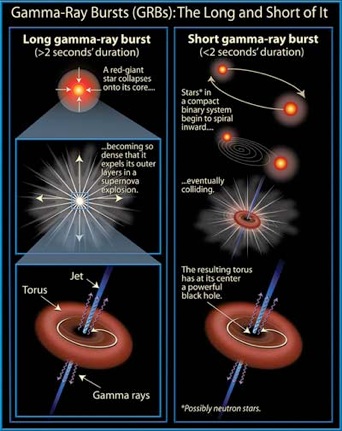GRBs - Their Importance
The great advantage of GRBs compared to other astronomical sources is their Gamma-ray brightness.
For the time of the explosion, for few minutes (in case of long GRB), they outshine any other sources in the sky. The interaction of the blastwave with the progenitor’s surrounding material produces low-energy emission (the “Afterglow”) observable in X-ray, Optical, Infrared and even Radio bands.
The afterglow is essentially synchrotron process emission which lasts from few days to months and carries important information on the progenitor’s nature and activity.
Afterglow spectroscopy shows often absorption features of several metal lines. The ions (at low and high ionized state) provide useful insight of the GRB Host galaxy environment, the excitation mechanism of these lines, metallicity and dust content. Most importantly, since these lines are redshifted based on their distances, they are the best tool to determine the Redshift of GRB.
Swift
In 2005 the Swift satellite was launched in order to discover Gamma-ray Burst from the first minute of theis explosion. Bringing onboard three instruments, the Burst Alert Telescope (BAT), the X-ray telescope (XRT) and the UV and Optical Telescope (UVOT) and thanks to a fast-slewing capability, the Swift satellite has been able to observe ~100 GRB/year. A large sample of this have been also observed from Earth, providing not only optical and infrared follow-up, but also redshift and chemical information about their host galaxies.
GRB 130603B
On June 3rd, 2013 two GRBs exploded. The second one in particular sparkled the interest of many GRB “aficionados”, because belongs to the short-class of GRB events. These GRBs are rare, much fainter than the “long” ones and their gamma-ray emission lasts only fraction of seconds. No clear, high quality spectrum of a short GRB afterglow was obtained until now, due to the rapidly fading emission. For this event several groups were able to obtain a optical spectrum (including my group, see Cucchiara et al. 2013). These data allows to constrain the properties of this short-GRB (SGRB) environment and, morover, to better understand the real nature of these event. In fact we think that short-GRBs are produced by compact objects binary systems, which at some point in their evolution coalesce and merge, producing the GRB events. In particular this event, has provided the first evidence that SGRBs are indeed produced (at least some of them) by such binaries. See Tanvir et al. 2013 and Berger et al. 2013.
GRB 090423 and GRB 090429B
In April 2009 two Gamma-ray bursts exploded providing incredible insight into the early stages of the Universe. Thanks to spectroscopic observations GRB 090423 revealed to be at redshift z = 8.2, one of the furthers object ever observed (Tanvir et al. 2009 and Salvaterra et al 2009).
GRB 090429B, instead, could not be observed with a spectrograph due to bad weather coverage over Hawaii. Optical and Infrared observations, early in the night, were the only data collected. Based on this dataset and from following observations using the Hubble Space Telescope we were able to determine a Photometric Redshift of z = 9.4 (-1.7,+0.3).
Few References:
Cucchiara et al. 2011: “A Photometric Redshift of z ~ 9.4 for GRB 090429B”
Tanvir et al. 2009
Salvaterra et al. 2009





